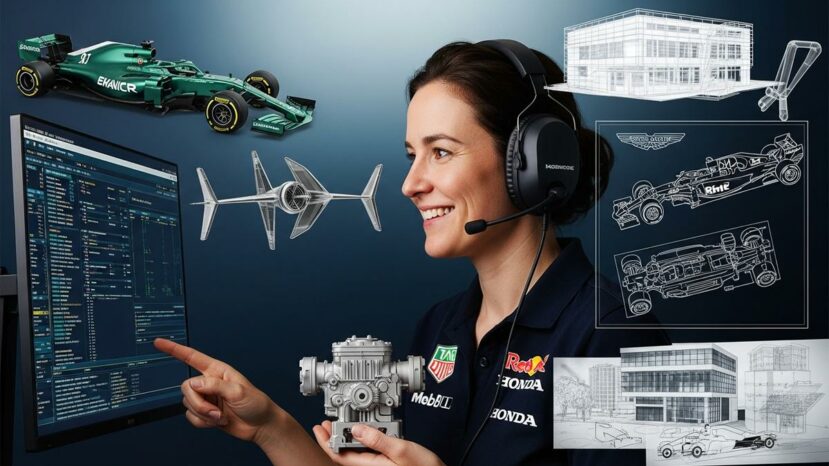Aston Martin and Honda coordinate F1 chassis and engine for 2026, between Silverstone and Sakura

Aston Martin and Honda make great strides towards 2026. The two partners are already laying the foundations for a far-reaching technical collaboration, designed for the new hybrid rules and for a sustainable rise in power.
The project is part of a tight but clear schedule. Teams are aligning methods, tools and priorities to turn vision into performance in the first race of the new cycle.
2026, the year of the great energy changeover
The frame changes radically, with the MGU-H disappearing and the MGU-K increased to almost 350 kW. The target power distribution approaches 50% hybridization, with 100% sustainable fuel. For Aston Martin, engine-chassis integration becomes strategic, as every liter of cooling and every kilo counts. As a result, packaging and aerodynamics have to be considered at an early stage.
Honda is structuring its work groups to match software, ERS and thermal architecture. In addition, the aim is to lock in the electronic and hydraulic interfaces as soon as possible. Aston Martin, for its part, is bringing its design offices into line with Sakura’s requirements. On the other hand, strict information barriers are being maintained with existing programs until the end of 2025.
“Early technical alignment saves months on the track.”
Governance, security and separation from legacy systems
Honda still supports Red Bull until the end of the 2025 season, which imposes a hermetic governance. However, preparations for the future are progressing without leaking sensitive information. Aston Martin is therefore working on compatible design “envelopes” and packaging scenarios. In this way, every decision respects legal frameworks and intellectual property.
Exchanges are based on CAD standards, digital mock-ups and hardware-in-the-loop benches. From now on, validation will be iterative, with clear milestones for ERS integration and cooling. Aston Martin is capitalizing on its recent testing resources to accelerate feedback loops. As a result, the risk of late rework is greatly reduced.
- 2026: new power units without MGU-H
- Hybridization target close to 50%.
- 100% sustainable fuel and joint work on compatibility
- Coordinated chassis-motor integration groups
- Firewalls to secure IP until the end of 2025
Shared timetable, resources and milestones
The schedule is based on bench and simulator validations. The focus will also be on energy management, recovery and traction interface. Aston Martin is planning correlation tests to align model and track. In short, the focus is on reliability before raw performance.
Industrial resources play a major role in this complex equation. The Silverstone campus provides a state-of-the-art wind tunnel and benches, which will be open to the team in 2024. In addition, Honda relies on Sakura and a stronger base in the UK for operational support. Aston Martin thus benefits from a geographical proximity useful for fast loops.
The human dimension remains central, with clear references on the engine and chassis sides. However, responsibilities are clearly defined to avoid grey areas. As a result, critical decisions are made through frequent, documented program reviews. This is where Aston Martin anchors its project management and sporting priorities.
Impact on chassis and drive train
The switch to a different engine manufacturer changes the situation for the gearbox and rear suspension. As a result, the team is preparing a more autonomous architecture to reduce dependencies. Aston Martin anticipates gains in control over wheelbase, center of gravity and unsprung masses. However, the first few weeks of operation will be a steep learning curve.
Cooling and energy management also guide the shape of the pontoons and stern. In addition, the MGU-K deployment strategy influences transmission ratios. Aston Martin works with the fuel partner on the optimum ignition and performance window. As a result, the chassis evolves in step with engine iterations.
What this means for fans and the competition
For fans, the grid will gain in technical diversity from the first season of the new rules. As a result, the battle of concepts will return to the forefront of Sunday discussions. Aston Martin arrives with a coherent package, designed for regeneration and efficiency. However, the margin for error will remain slim in the face of the historic giants.
By 2026, there should be 6 engine manufacturers on the grid, each with its own energy philosophy. The difference between high-altitude circuits and slower tracks will also be a key factor. Aston Martin will then play the aero mechanical consistency card over the season. As a result, regularity could be as important as peak performance.
The increase in in-house skills will create new benchmarks for the Silverstone-based team. From now on, the ability to decide quickly and well will make all the difference at the weekend. Aston Martin is aiming for a balance between robustness and speed of development. As such, the collaboration with Honda is part of a multi-year trajectory, with clear and measurable milestones.





No comments
Post a comment
Always participate in accordance with the law and with respect for others.